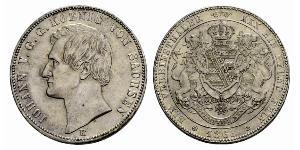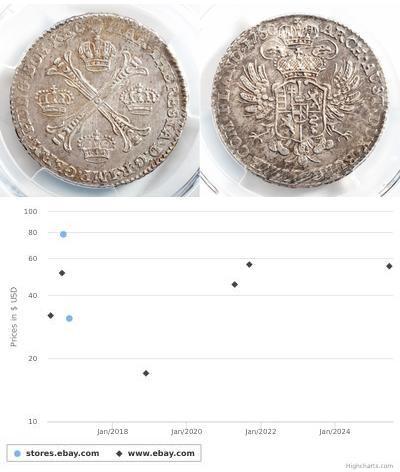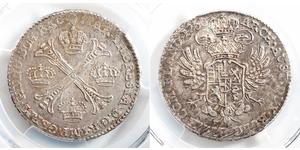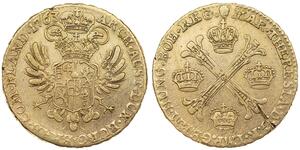1 Талер (продана за $134.0)
1624, Bohemia, Emperor Ferdinand II. Silver ½ Thaler Coin. Kuttenberg mint!
Mint Year: 1624
Denomination: ½ Thaler
Mint Place: Kuttenberg (Kutna Hora)
Mint Master: Sebastian Holzl (privy mark: star)
Reference: Halacka 801, Dietiker 696, KM-349.
Condition: Removed suspension loop, double-struck, toned, mint-made planchet splits, otherwise VF+
Weight: 14.45gm
Diameter: 38mm
Material: Silver
Obverse: Standing crowned and armoured figure of Ferdinand II right, wearing rapier in shelf and holding scepter and cross-topped orb.
Legend: FERDINANDVS . II D:G R. IM . S : A . G . H . BO . REX
Translation: "Ferdinand II, by the grace of God, Emperor of the Romans, Ever Augustus, King of the Germans, Hungary, and Bohemia"
Reverse: Crown above double-headed eagle with Bohemian coat-of-arms at chest. Mint master´s mark (*) in legend below.
Legend: ARCHID AVSTR . DVX (privy mark: star) BVRG . MAR . MO . 1624
Translation: "Archduke of Austria, Duke of Burgundy, Margrave of Moravia . 1624"
In the Holy Roman Empire, the Thaler was used as the standard against which the various states' currencies could be valued.
Ferdinand II, Holy Roman Emperor (July 9, 1578 – February 15, 1637), of the House of Habsburg, reigned as Ferdinand II, Archduke of Inner Austria (normally called Ferdinand II of Germany when referred to as Archduke) and Holy Roman Emperor from 1619-1637. He was also the Archduke of Styria (Inner Austria) from 1590–1637, King of Bohemia from 1617-1619 and again from 1620-1637, as well as King of Hungary and Croatia from 1618-1625. The expansion of the ongoing acts of rebellion against his Imperial Governors in Bohemia on May 23rd, 1618 directly triggered the Thirty Years' War, and can be blamed on his religious intolerance toward Protestants.
A devout and very pious Catholic, his recognition as King of Bohemia and suppression of Protestantism precipitated the early events of the Thirty Years' War, and he remained one of the staunchest backers of the Anti-Protestant Counter Reformation efforts as one of the heads of the German Catholic League, prolonging the Thirty Years' Wars by insisting the Edict of Restitution be enforced. The duration of his reign was occupied by confessional and military concerns, and some historians blame him for the large civilian loss of life in the Sack of Magdeburg in 1631, as he'd instructed Count Tilly to enforce the edict upon Saxony—his orders causing Tilly to move the Catholic armies east, ultimately to Leipzig, where they suffered their first substantial defeat at First Breitenfeld.
In 1617, Ferdinand was elected King of Bohemia by the Bohemian Diet. He also secured support from the Spanish Habsburgs for his claim to succeed the childless Emperor Matthias on the throne, granting them future rule over Alsace and Imperial fiefs in Italy. Ferdinand's staunch Catholicism led to infringements on the religious freedoms of non-Catholics. Among other things, the king did not respect the religious freedoms granted in the Majestät (or "Majestic Letter") signed by the earlier emperor Rudolf II to end the Brothers' War, which had granted freedom of worship to nobles and the inhabitants of cities. Additionally, Ferdinand was an absolutist and infringed upon what nobles regarded as secular rights. Given the relatively large number of Protestants within the kingdom, including many among the noble classes, the new king soon became unpopular and some dissidents participated in the ensuing Bohemian Revolt. On May 22, 1618, two royal (Catholic) officials in Prague were thrown out a castle window by Bohemian Protestants (the Defenestration of Prague). Though the officials were uninjured, such actions did not fall within the realm of standard protocol, and the clear offense against the royal dignity led to a hardening of attitudes and full rebellion.
The nobility revolted against Ferdinand and replaced him with the Protestant Elector Frederick V of the Palatinate, known as the "Winter King."
Emperor Matthias died in Vienna in March 1619. As earlier agreed, Ferdinand succeeded him on the throne. Supported by the Catholic League, which included the rulers of Poland, Spain, and Bavaria, Ferdinand sought to reclaim his Bohemian possessions and stamp out the Protestant rebellion. On November 8, 1620, Catholic forces engaged those supporting the Protestant Frederick, who had taken the Bohemian kingship, at the Battle of White Mountain. After only two hours of fighting, the Catholics emerged victorious. The now-deposed Frederick fled to the Netherlands and Duke Maximilian I of Bavaria, the leader of the Catholic League, moved to confiscate his lands in the Palatinate. The restored Ferdinand set about strengthening the Catholic church in Bohemia, reduced the authority of the Diet, and forcibly converted Austrian and Bohemian Protestants.
By 1625, despite receiving subsidies from the Spanish and the Pope, Ferdinand was strapped for cash and looking for a means to raise his own army. His solution was to charge the Bohemian soldier and "military entrepreneur" Albrecht von Wallenstein with raising and commanding an Imperial army. Wallenstein accepted the position with the proviso that the management (and possession) of the army's funds were solely his, as was the right to take and distribute loot and ransoms taken in the course of operations. Quickly raising at least 30,000 men (he would later command at least 100,000), and fighting alongside the Catholic League army under the Count of Tilly, Wallenstein defeated Protestant forces in Silesia, Anhalt, and Denmark.
With his forces scoring important victories against the Protestants, Ferdinand crowned his religious policies by issuing his Edict of Restitution (1629), which was designed to restore all ecclesiastical properties which had been secularized since the Peace of Passau in 1552. This blatantly pro-Catholic policy has been widely credited with bringing the Protestant King of Sweden, Gustavus Adolphus, into the war against Ferdinand.
Despite the successes of Wallenstein, many of Ferdinand's advisors saw a genuine political threat in the general, citing his growing influence, his increasing number of estates and titles, as well as his extortionate methods of raising funds for his army. Ferdinand responded by dismissing Wallenstein in 1630. With the loss of his commander, he was once again forced to rely on the Catholic League army under Tilly, who was unable to stem the Swedish advance and was killed in 1632. As a result, Ferdinand recalled Wallenstein from retirement.
In the spring of 1632, Wallenstein raised a fresh army in a matter of weeks and drove the Protestant army out of Bohemia. In November came the great Battle of Lützen, at which the Catholics were defeated, but Gustavus Adolphus was killed. Wallenstein withdrew to winter quarters in Bohemia. Although he had lost strategically and been forced out of Saxony, the Protestants had suffered much greater casualties.
The campaigning of 1633 was indecisive, partly because Wallenstein was negotiating with the enemy, thinking that the army would be loyal to him, rather than Ferdinand, and follow him if he switched sides. In early 1634, he was openly accused of treason and assassinated at Eger, probably at Ferdinand's instigation.
Despite the loss of Wallenstein, Imperial forces took Regensburg and won a victory at the Battle of Nördlingen. Swedish strength was greatly weakened, but France entered the war on the side of the Protestants out of fear of Habsburg domination. Although the country was Catholic, France feared both the Germans and the Spanish, so Cardinal Richelieu convinced King Louis XIII of France to ally himself with the Dutch and the Swedes.
The French were highly dissatisfied with the terms of the Peace of Prague concluded in 1635, the last important act of Ferdinand. Therefore, although a treaty was signed, peace did not come. At Ferdinand's death in 1637, his son Ferdinand III inherited an embattled empire.

|
Добавив:
anonymous 2015-11-01 |
|
||
|
||
|
||
|
||
|
||
1/2 Kronenthaler Нідерланди Срібло
в групі 9 монет / 8 цін
⇑

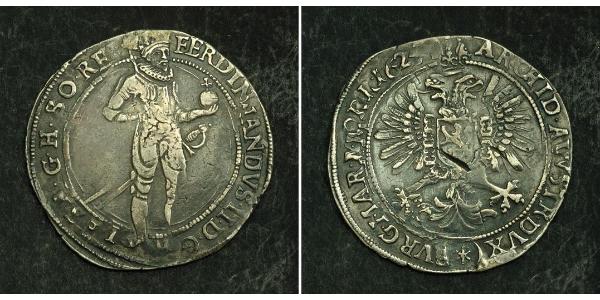


 Deutsch
Deutsch Русский
Русский Українська
Українська English
English Italiano
Italiano Français
Français Español
Español 汉语
汉语




